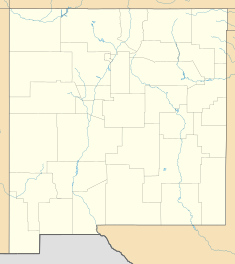High Road to Taos, New Mexico
| High Road to Taos | |
|---|---|

Truchas, with Truchas Peaks in background
|
|
| Location | New Mexico |
| Coordinates | 35°53′49″N 106°1′12″W / 35.89694°N 106.02000°WCoordinates: 35°53′49″N 106°1′12″W / 35.89694°N 106.02000°W |
| Designated | February 28, 1975 |
| Reference no. | 363 |
The 56-mile (90 km) High Road to Taos is a scenic, winding road through the Sangre de Cristo Mountains between Santa Fe and Taos. (The "Low Road" runs through the valleys along the Rio Grande). It winds through high desert, mountains, forests, small farms, and tiny Spanish Land Grant villages and Pueblo Indian villages. Scattered along the way are the galleries and studios of traditional artisans and artists drawn by the natural beauty. It has been recognized by the state of New Mexico as an official Scenic Byway.
The High Road to Taos Scenic Byway begins north of Santa Fe in Pojoaque, New Mexico, at the intersection of U.S. 285/84 and State Road 503. It continues along State Road 503 to Nambé Pueblo. Founded in the 14th century, Nambé means "People of the Round Earth" in Tewa, their native language. The pueblo plaza is a registered National Historic Landmark. The church on State Road 503 is not original; ill-considered efforts to restore the grand original church caused it to collapse. The pueblo encompasses 19,000 acres (77 km2) of land with waterfalls, lakes, and mountainous areas. Until about 1830, Nambe was known for a pottery style called Nambe Polychrome. Today, pottery is making a comeback, especially black-on-black and red-on-white. Weaving is also reemerging.
The road continues through the rolling hills and wind-carved hoodoos of the badlands. At 7.5 miles (12.1 km), the High Road turns left onto State Road 98 (Juan Medina Road), which continues across the open, rolling high desert until it dips down to the green, farming valley of Chimayó. Visitors often stop at the historic Santuario de Chimayó. Built between 1811 and 1816, this tiny church is visited by pilgrims from all over the United States and old Mexico, especially on Good Friday of Easter week, when crowds swell to the thousands. A little farther on is the Rancho de Chimayó Restaurant, housed in a historic adobe building. Chimayó also has many traditional weaving studios owned by descendants of the original Spanish settlers.
...
Wikipedia

